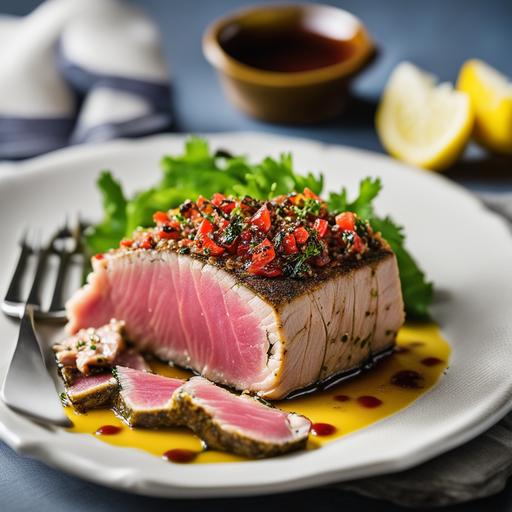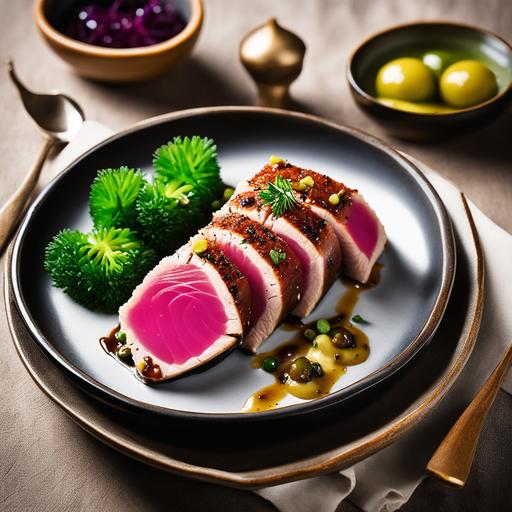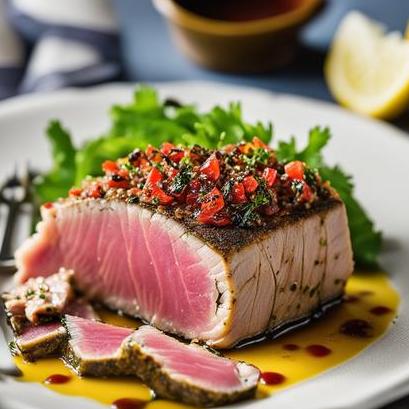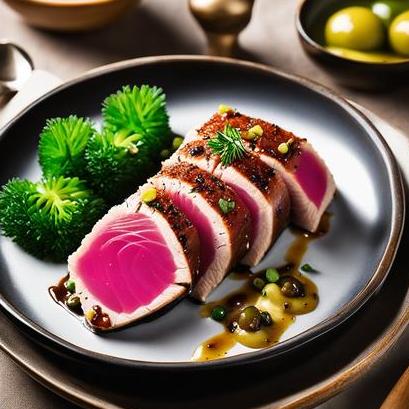
The Ultimate Tuna Oven Recipe: A Culinary Delight
Tuna is a versatile and nutritious fish that is enjoyed by seafood aficionados around the world. With its meaty texture and rich flavor, tuna can be prepared in numerous ways, but one method that truly highlights its taste and succulence is cooking it in the oven. In this comprehensive guide, we will delve into the art of preparing a mouthwatering tuna oven dish. From understanding the food science behind cooking tuna to step-by-step instructions, we will cover every aspect of this delectable and wholesome recipe.
Food Science: The Perfect Tuna Cooking Temperature
Before we dive into the culinary details, it’s important to understand the food science behind cooking tuna to achieve the perfect texture and taste. Tuna is a dense fish with moderate fat content, which makes it best suited for quick cooking methods like grilling, searing, or baking. However, overcooking tuna can lead to a dry and tough texture.
To achieve a succulent tuna, it is crucial to cook it to a doneness level that retains its moistness. The ideal internal temperature for cooked tuna should range between 120°F (49°C) and 145°F (63°C), depending on personal preference. For a medium-rare tuna, aim for an internal temperature of around 120°F (49°C), while a medium doneness level corresponds to a temperature of approximately 130°F (54°C). If you prefer a well-done tuna, a temperature of 145°F (63°C) is recommended.
Selecting the Perfect Tuna
When it comes to selecting tuna for your oven recipe, it’s important to choose the freshest fish available. Look for firm, shiny flesh with a vibrant red color. Avoid any tuna that appears dull or slimy, as it may indicate poor quality or freshness. It’s also advisable to purchase tuna steaks that are at least 1 inch thick to ensure even cooking in the oven.
Cleaning and Preparation

-
Begin by rinsing the tuna steaks under cold water to remove any lingering impurities.
-
Pat the steaks dry with paper towels, ensuring they are completely moisture-free.
-
Trim any excess fat or skin, if desired, to your preference.
Marinating and Flavor Enhancements

Marinating tuna can elevate its taste profile by infusing it with additional flavors. Below are a couple of marinade options to consider:
-
Soy Ginger Marinade: Combine soy sauce, grated ginger, minced garlic, and a touch of honey for a balanced and aromatic marinade.
-
Citrus Herb Marinade: Mix fresh lemon or lime juice with thyme, parsley, minced garlic, and olive oil for a zesty and herbaceous infusion.
Once you have prepared the desired marinade, place the tuna steaks in a shallow dish or resealable bag. Pour the marinade over the steaks, ensuring they are fully coated. Marinate the tuna in the refrigerator for at least 30 minutes or up to 2 hours for maximum flavor penetration.
Tips for Cooking Tuna to Perfection

To ensure your tuna oven recipe turns out flawless, consider the following tips:
-
Preheat your oven to 425°F (220°C) for optimal cooking conditions.
-
Use a non-stick baking dish or line a regular baking dish with aluminum foil to prevent sticking.
-
If using a marinade, remove the tuna from the marinade and lightly pat it dry with paper towels before placing it in the oven.
-
For an enhanced presentation, sear the tuna in a hot skillet for 1-2 minutes on each side before transferring it to the oven.
-
Avoid overcrowding the baking dish, allowing space between the steaks for even heat distribution.
-
Baste the tuna with melted butter, olive oil, or additional marinade during cooking to keep it moist and impart more flavor.
Cooking Time and Doneness Check

The cooking time for tuna steaks in the oven depends on the desired doneness level and the thickness of the steaks. Follow these general guidelines:
-
For medium-rare: Cook the tuna for 8-10 minutes.
-
For medium: Cook the tuna for 10-12 minutes.
-
For well-done: Cook the tuna for 12-15 minutes.
To check the doneness, use a meat thermometer inserted into the thickest part of the steak. Ensure it reaches the desired internal temperature mentioned earlier.
Oven Recipe: Tuna Steak with Lemon Herb Butter
Ingredients:
-
4 tuna steaks (approximately 1 inch thick)
-
1/4 cup unsalted butter, softened
-
2 tablespoons freshly squeezed lemon juice
-
1 tablespoon chopped fresh parsley
-
1 tablespoon chopped fresh thyme
-
Salt and pepper to taste
Instructions:
-
Preheat your oven to 425°F (220°C).
-
In a small bowl, combine the softened butter, lemon juice, parsley, thyme, salt, and pepper. Mix until well incorporated.
-
Pat the tuna steaks dry with paper towels and place them in a non-stick baking dish or lined baking dish.
-
Spread the lemon herb butter mixture evenly over the top of each tuna steak.
-
Place the baking dish in the preheated oven and cook according to the desired doneness level (refer to previous guidelines for cooking times).
-
Once cooked to your preference, remove the tuna steaks from the oven and let them rest for a few minutes before serving.
Variations and Serving Suggestions
While the above recipe offers a tantalizing lemon herb butter flavor, there are numerous variations you can explore to suit your taste preferences. Consider the following options:
-
Sesame Ginger Glaze: Replace the lemon herb butter with a glaze made from toasted sesame oil, grated ginger, soy sauce, and honey.
-
Spicy Cajun Rub: Rub the tuna steaks with a blend of paprika, cayenne pepper, garlic powder, onion powder, dried thyme, and salt for a fiery Cajun twist.
Serve your oven-baked tuna steaks alongside a variety of delectable accompaniments:
-
Lemon or lime wedges: Squeeze fresh citrus juice over the tuna for an added burst of freshness.
-
Roasted Asparagus: Pair the tuna with tender roasted asparagus spears seasoned with olive oil, salt, and pepper.
-
Herbed Quinoa: Serve the tuna over a bed of flavorful and nutritious quinoa cooked with herbs like thyme, rosemary, and parsley.
Conclusion
Cooking tuna in the oven can yield a scrumptiously tender and flavorful result. By understanding the food science behind achieving the perfect doneness level, selecting fresh tuna, and following the detailed preparation steps, you can create a masterpiece in your kitchen. With the provided recipe, variations, and serving suggestions, you have the tools to impress your guests or simply treat yourself to a delightful tuna feast. So, roll up your sleeves, gather your ingredients, and embark on a culinary adventure with this ultimate tuna oven recipe. Bon appétit!
Sources
FAQS On Tuna Oven Recipe
What Ingredients Do I Need To Make A Tuna Oven Recipe?
To make a tuna oven recipe, you will need tuna steak, olive oil, lemon juice, garlic, and your choice of herbs and spices.
Can I Use Canned Tuna For This Recipe?
Yes, you can use canned tuna instead of fresh tuna steak for this recipe. Just make sure to drain the canned tuna well before using.
How Long Does It Take To Cook The Tuna In The Oven?
The cooking time will depend on the thickness of your tuna steak and your desired level of doneness. Typically, it takes 10-12 minutes to cook tuna steak in the oven.
Can I Marinate The Tuna Before Cooking It In The Oven?
Yes, marinating the tuna can add an extra depth of flavor to your dish. You can marinate the tuna for at least 30 minutes or up to 2 hours in the fridge before cooking.
How Do I Know When The Tuna Is Done Cooking?
Tuna is best enjoyed when cooked to medium-rare or medium doneness. You can check the internal temperature of the tuna using a meat thermometer – 125°F for medium-rare or 145°F for medium. Alternatively, you can also check the doneness by cutting into the thickest part of the tuna and checking the color – a light pink center indicates medium-rare while a light brown center is medium.


